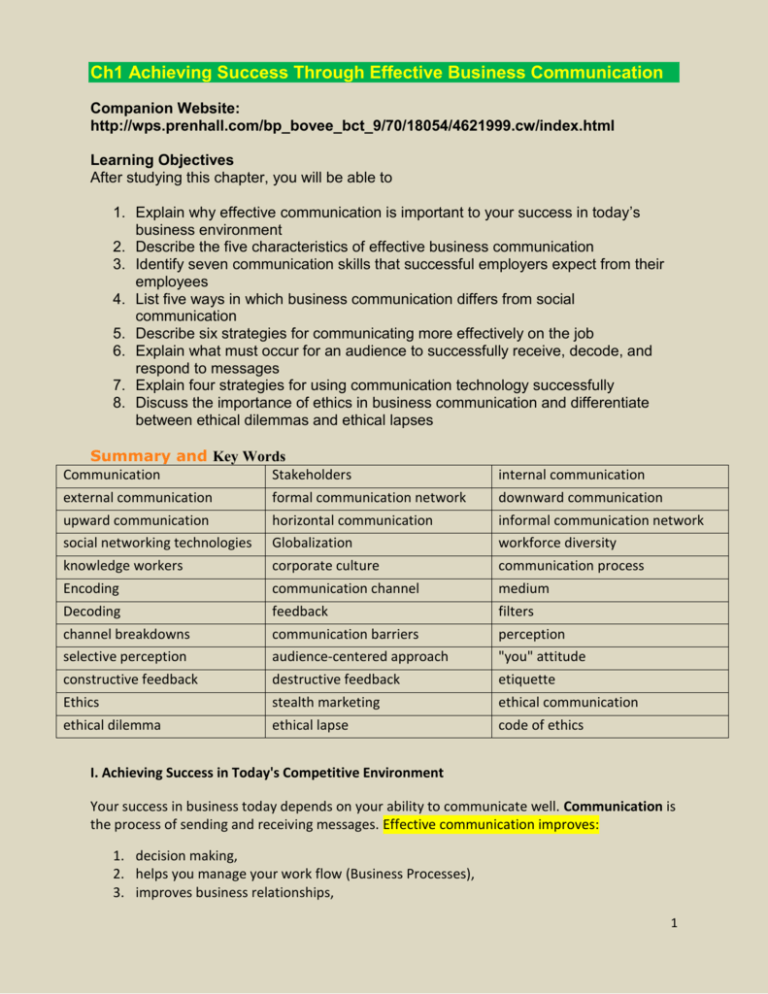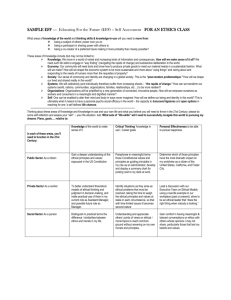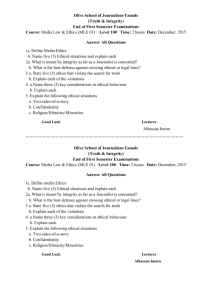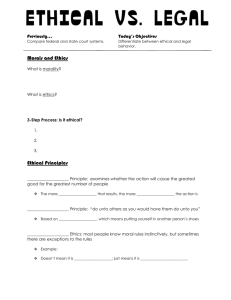ch01 Achieving Success BC - TW-arafat - Home
advertisement

Ch1 Achieving Success Through Effective Business Communication Companion Website: http://wps.prenhall.com/bp_bovee_bct_9/70/18054/4621999.cw/index.html Learning Objectives After studying this chapter, you will be able to 1. Explain why effective communication is important to your success in today’s business environment 2. Describe the five characteristics of effective business communication 3. Identify seven communication skills that successful employers expect from their employees 4. List five ways in which business communication differs from social communication 5. Describe six strategies for communicating more effectively on the job 6. Explain what must occur for an audience to successfully receive, decode, and respond to messages 7. Explain four strategies for using communication technology successfully 8. Discuss the importance of ethics in business communication and differentiate between ethical dilemmas and ethical lapses Summary and Key Words Communication Stakeholders internal communication external communication formal communication network downward communication upward communication horizontal communication informal communication network social networking technologies Globalization workforce diversity knowledge workers corporate culture communication process Encoding communication channel medium Decoding feedback filters channel breakdowns communication barriers perception selective perception audience-centered approach "you" attitude constructive feedback destructive feedback etiquette Ethics stealth marketing ethical communication ethical dilemma ethical lapse code of ethics I. Achieving Success in Today's Competitive Environment Your success in business today depends on your ability to communicate well. Communication is the process of sending and receiving messages. Effective communication improves: 1. decision making, 2. helps you manage your work flow (Business Processes), 3. improves business relationships, 1 4. enhances your professional image, 5. and provides other important benefits. Effective communication improves the connections between an organization and its stakeholders--groups affected in some way by the company's actions: customers, employees, shareholders, suppliers, neighbors, the community, and the nation. Hence communication breaks down, the results can be anywhere from time-wasting to tragic. At every stage of your career, communication is the way you’ll succeed. Employers expect from you the same skills that will help you advance your career. organizing ideas and information logically and completely expressing and presenting ideas and information coherently and persuasively listening to others effectively communicating effectively with people from diverse backgrounds and experiences using communication technologies effectively and efficiently following accepted standards of grammar, spelling, and other aspects of high-quality writing and speaking communicating in a civilized manner that reflects contemporary expectations of business etiquette. communicating ethically, even when choices aren't crystal clear. To make your messages effective, make them : practical, factual, concise, clear, and persuasive. You exchange information with people inside your organization, called internal communication, and you exchange information and ideas with others outside your organization, called external communication. Every organization has a formal communication network, in which ideas and information flow along the lines of command (the hierarchical levels) in your company's organization structure. Throughout the internal formal network, communication flows in three directions: 1- downward communication from executives to employees, sharing executive decisions and providing information that helps employees do their jobs; 2- upward communication from employees to executives, providing accurate, timely reports on problems, trends, opportunities, grievances, and performance—thus allowing executives to solve problems and make intelligent decisions; and 3- horizontal communication between departments to help employees share information, coordinate tasks, and solve complex problems. Every organization also has an informal communication network—a grapevine—that operates anywhere two or more employees are in contact, from the lunchroom to the golf course. Informal exchanges outside the company are now considered so important that a new class of technology has sprung up to enable them. Social networking technologies such as Facebook, wikispaces, are Myspace are examples, as are software and web sites such as Spoke Connect, LinkedIn.com, and Ryze.com. 2 Business communication is different from your communication with family, friends, and school associates. Several factors make business communication unique: Globalization as today's businesses increasingly reach across international borders to market their products, partner with other businesses, and employ workers and executives. Workforce diversity—all those differences among the people you come into contact with on the job, including age, gender, sexual orientation, education, cultural background, life experience, and so on. The value of business information as organizations increasingly rely on knowledge workers at all levels of the organization, employees who specialize in acquiring, processing, and communicating information. Knowledge workers communicate in such key areas as competitive insights, customer needs, and regulations and guidelines. The pervasiveness of technology also makes business communication unique. Taking advantage of technology requires time, energy, and the improvement of skills; you'll need to keep up with your co-workers. The evolution of organizational structures also affects business communication. Whether your organization uses a tall structure with many layers of management, or a flatter structure with fewer layers, your communication efforts will be influenced by the corporate culture—the mixture of values, traditions, and habits that give a company its atmosphere and personality. II. Communicating More Effectively on the Job To connect with your audience, you need to understand the communication process, barriers in the communication process and understand how the minds of your audience work. Communication is a process with several phases: 1. The sender has an idea. You conceive an idea and want to share it. 2. The sender encodes the idea as a message. . When you put your idea into a message that your receiver will understand, you are encoding it. 3. The sender produces the message in a transmittable medium (oral, written, visual, electronic). 4. The sender transmits the message. To transmit your message to your receiver, you select a communication channel such as the telephone, a letter, a memo, an e-mail— even a facial gesture. 5. The audience receives the message. Arrival of the message does not guarantee that it will be noticed or understood correctly. 6. The audience decodes the message. Your receiver extracts your idea from the message in a form that he or she can understand, a step known as decoding. 7. The audience responds to the message. By showing the benefits of responding, you can increase the chances that your audience will respond the way you'd like them to. 8. The audience sends feedback. The audience may also give feedback that helps you to evaluate the effectiveness of your message. Messages can be disrupted by a variety of communication barriers. These include 3 noise and distractions—anything from poor acoustics, multitasking, and worrying about keeping your job. competing messages—too many of which can result in information overload. filters—anything from spam blockers to corporate organizations which inhibit the flow of information. channel breakdowns—anything from a colleague forgetting to deliver a message to a brochure getting lost in the mail. Understanding how audiences receive, decode, and respond to messages will help you create more effective messages. To get your messages noticed, follow these five principles: consider audience expectations ensure ease of use emphasize familiarity practice empathy design for compatibility Understanding how audiences decode messages will help you write effective messages. There is no guarantee that the audience will assign the meaning you intended because decoding is a very personal process affected by culture, individual experience, learning and thinking styles, hopes, fears, and even temporary moods. Our minds organize incoming sensations into a mental map that represents our individual perception of reality. If a detail doesn't fit for any reason, people are inclined to distort the information rather than rearrange the pattern—a process known as selective perception. Language differences can also influence a received meaning if two people define a word or phrase differently; for example, "as soon as possible." The more shared experience between the sender and receiver the more likely it is that the meaning of words will be the same. Understanding how audiences respond to messages will also help you write effective messages. Three things need to occur: The recipient needs to remember the message long enough to act on it. The recipient has to be able to respond as you wish. The recipient has to be motivated to respond. Minimizing distractions can improve the communication process. Physical distractions range from cell phones and music to excessive and unnecessary e-mail messages; emotional distractions can affect the way you prepare messages and the way your audiences respond to those messages. An audience-centered approach means focusing on and caring about the members of your audience, making every effort to get your message across in a way that is meaningful to them. This approach is also known as the "you" attitude. Fine-tuning your business communication skills means learning from experience and this textbook, especially in taking an audiencecentered approach. You will encounter numerous situations in which you are expected to give and receive feedback. Constructive feedback focuses on the processes and outcomes of communication in 4 order to promote improvement, not on the people involved. Destructive feedback delivers criticism with effort to stimulate improvement. Being sensitive to business etiquette (the expected norms of behavior in a particular situation) can have a profound effect on your company's success and your career. III. Using Technology to Improve Business Communication Technology can improve business communication in many ways, including instant messaging, blogging, videoconferencing, extranets, package tracking, podcasting, and many others. You will need to use these tools effectively, but no technology cannot match the rich experience of person-to-person contact. IV. Making Ethical Communication Choices As a communicator, you will need to act ethically. Ethics are the accepted principles of conduct that govern behavior within a society. However people in a society don't always agree on what constitutes ethical behavior; for example, whether stealth marketing (when people don't know they are being marketed to) is ethical. Ethical communication includes all relevant information, is true in every sense, and is not deceptive in any way. Examples of unethical communication include plagiarism, selective misquoting, misrepresenting numbers, and distorting visuals. An ethical dilemma involves choosing among alternatives that aren't clear-cut (perhaps two conflicting alternatives are both ethical and valid, or perhaps the alternatives lie somewhere in the gray area between clearly right and clearly wrong). An ethical lapse is a clearly unethical or illegal choice. A code of ethics helps employees determine what is acceptable. Many companies use ethics audits to ensure compliance with their code of ethics. Self-Study Quiz: Learning Activity http://cp02.coursecompass.com/webapps/portal/frameset.jsp?url=%2Fbin%2Fcommon%2Fcourse.pl%3Fcourse_id%3D_106813_1 Go to Amazon.com to browse the book I See What You Mean: Persuasive Business Communication by D. Joel Whalen, published by Sage Publications. Click on the Search Inside icon to read the excerpt. List the "central leverage points of effective communication" on the first two pages of chapter one. 5








